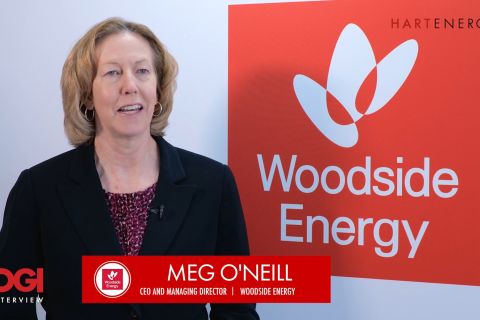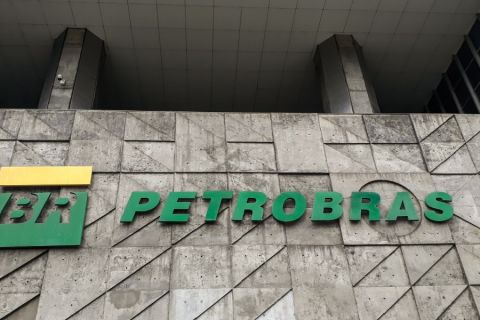
Tetra Tech Water & Carbon Adviser Michael Dunkel (left) and Quantum Capital Group Managing Director and Head of Technical Basak Kurtoglu (right) discuss barriers to CCS projects during Hart Energy’s Carbon & ESG Strategies conference. (Source: Hart Energy)
Companies and governments worldwide have set lofty net zero emissions goals. But looming over those ambitions are bureaucratic red tape, expensive projects and technology that is needed but doesn’t yet exist.
The most prominent solution is carbon capture and storage (CCS)—an emerging sector the U.S. and others are trying to foster through billions of dollars in tax credits.
Despite those incentives, CCS faces some serious headwinds, executives said during an event hosted by Hart Energy.
“Achieving net zero emissions goals really requires widespread adoption to clean molecule or clean electron solutions,” Basak Kurtoglu, Quantum Capital Group’s managing director and head of technical, said Aug. 31 during Hart Energy’s Carbon & ESG Strategies conference in Houston.
During the panel discussion, Kurtoglu said no silver bullet technology is currently available to mitigate all emissions.
Direct air capture (DAC) is still in development mode, although companies such as Occidental Petroleum are spending billions to develop the tech.
However, Kurtoglu said the industry is still years away from implementing DAC on a commercial-scale—although efforts are under way to change that and lower costs.
Costs are also a challenge for CCS, although she said storing carbon has the potential to “address many emissions, including hard to abate emissions which really have limited commercial alternatives to fossil fuel use.”
Kurtoglu said capture costs depend on the type of emission source, among other factors.
And not all CO2 emissions are created equal, she said.
Further innovation is needed to reduce the cost curve for lower purity sources that comprise the bulk of CO2 emissions.
The cost to capture a ton of CO2, for instance, rises depending on the activity that is generating it. Capturing ethanol and ammonia, for instance, can range from $25 per ton to $45 per ton of CO2.
Iron and steel capture costs range from $60 per ton to $125 per ton of CO2; Coal-fired power generation, $65 to $145; Power generation from natural gas, $75 to $150; And capture costs for cement can range from $70 to $200 per ton, Kurtoglu said.
However, several obstacles still stand in the way of CCS deployment, Tetra Tech water and carbon adviser Michael Dunkel said.
‘Pore space race’
Carbon sequestration, the process of capturing and storing atmospheric CO2, is one method of reducing from the atmosphere the primary greenhouse-gas emitted from human activities, according to the U.S. Geological Survey.
Dunkel cited among the immediate challenges an evolving regulatory framework, long waits to secure Class VI permits and finding suitable reservoirs for storage, along with monitoring and reporting.
Further out, limited standards for baseline monitoring, testing and plume monitoring, data management and possible triggering events will also have to be addressed, he said.
Dunkel said the Inflation Reduction Act increased and extended CCS tax credits, and that projected capacity of CCS was “going through the roof,” with North America leading the push.
Over the next five years, Dunkel said, the first movers in the CCS space will have an advantage and the potential to corner markets in what he called the “pore space race,” while expanding CO2 networks would connect sources with the best geology.
Ultimately, for CCS to be successful, companies will need to find alignment with other stakeholders, Kurtoglu said, adding the best partners will be those within the sequestration value chain.
Recommended Reading
CEO: Continental Adds Midland Basin Acreage, Explores Woodford, Barnett
2024-04-11 - Continental Resources is adding leases in Midland and Ector counties, Texas, as the private E&P hunts for drilling locations to explore. Continental is also testing deeper Barnett and Woodford intervals across its Permian footprint, CEO Doug Lawler said in an exclusive interview.
Exxon Versus Chevron: The Fight for Hess’ 30% Guyana Interest
2024-03-04 - Chevron's plan to buy Hess Corp. and assume a 30% foothold in Guyana has been complicated by Exxon Mobil and CNOOC's claims that they have the right of first refusal for the interest.
Petrobras to Step Up Exploration with $7.5B in Capex, CEO Says
2024-03-26 - Petrobras CEO Jean Paul Prates said the company is considering exploration opportunities from the Equatorial margin of South America to West Africa.
The OGInterview: How do Woodside's Growth Projects Fit into its Portfolio?
2024-04-01 - Woodside Energy CEO Meg O'Neill discusses the company's current growth projects across the globe and the impact they will have on the company's future with Hart Energy's Pietro Pitts.
Petrobras Sending Nearly Half of Oil Exports to China
2024-04-30 - Conflict in the Middle East has enabled Brazil’s state-owned Petrobras to change the flow of its oil exports, with China being the primary beneficiary, followed by Europe.






